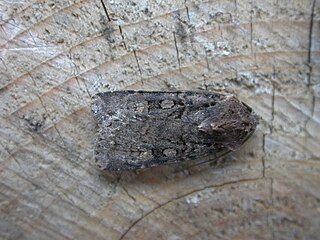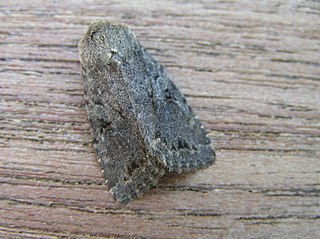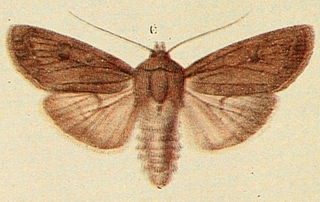
The garden dart is a moth of the family Noctuidae. It is distributed throughout much of the Palearctic. Temperate regions of Europe, Central Asia and North Asia, as well as the mountains of North Africa. Absent from polar regions, on Iceland and some Mediterranean islands, as well as in Macaronesia.

The square-spot rustic is a moth of the family Noctuidae. It is found in Europe, North Africa and east across the Palearctic and in North America.

Apamea monoglypha, the dark arches, is a moth of the family Noctuidae. The species was first described by Johann Siegfried Hufnagel in 1766. It is a common, sometimes abundant, European species. It is found in most of Europe except northernmost Fennoscandia and the southern parts of the Iberian Peninsula and Greece. The species is also found in Anatolia, Turkestan, Western Asia and Central Asia, Siberia and Mongolia. In the Alps it is found up to heights of 2,500 meters. The smaller subspecies sardoa is found on Sardinia and Corsica.

Apamea crenata, known as the clouded-bordered brindle, is a moth in the family Noctuidae. It is distributed throughout the Palearctic realm. In the North it crosses the Arctic Circle, in the Mediterranean it is found only in cool locations and mountains avoiding very hot areas. In the Alps, it rises to an altitude of about 2000 metres.

Conistra erythrocephala, the red-headed chestnut, is a moth of the family Noctuidae. It is distributed in central and southern Europe and is recorded from Asia Minor, (Amasia).

Orthosia incerta, the clouded drab, is a species of moth of the family Noctuidae, found in Europe and Asia. The occurrence of the species extends through all European countries through the Palearctic to the Russian Far East and Japan. It is absent from northern Fennoscandia and in the Alps it occurs up to 2000 m above sea level.

Fissipunctia ypsillon, the dingy shears, is a species of moth of the family Noctuidae. It is found in the Palearctic realm.

The Early Grey(Xylocampa areola) is a species of moth of the family Noctuidae. It is found in Europe and Morocco.

Polia bombycina is a moth of the family Noctuidae. It is found in the Palearctic realm from Ireland to Japan including the Russian Far East and Siberia.

Helotropha leucostigma, the crescent, formerly Celaena leucostigma is a moth of the family Noctuidae. It is found in the Palearctic realm.

Xanthia gilvago, the dusky-lemon sallow, is a moth of the family Noctuidae. The species was first described by Michael Denis and Ignaz Schiffermüller in 1775. It is found in Europe.

Lacanobia contigua, the beautiful brocade, is a moth of the family Noctuidae. The species was first described by Michael Denis and Ignaz Schiffermüller in 1775. It is found throughout temperate regions of the Palearctic realm, from Ireland east to Siberia and Japan.

Mesapamea secalis, the common rustic, is a moth of the family Noctuidae. The species was first described by Carl Linnaeus in his 1758 10th edition of Systema Naturae. It is found in Europe, north-west Africa, Turkey and northern Iran.

Coranarta cordigera, the small dark yellow underwing, is a moth of the family Noctuidae. The species was first described by Carl Peter Thunberg in 1788. It can be found in parts of Europe, mainly in the north. In central and southern Europe it is only found in mountainous areas. In the Alps for instance, it is found up to elevations of 2,200 meters.

Agrotis trux, the crescent dart, is a moth of the family Noctuidae. The species was first described by Jacob Hübner in 1824. It has a circum-Mediterranean distribution and is found along the coasts of France, Ireland, England, southern Europe, Algeria, Syria, Iraq, Iran, southern Russia and the Arabian Peninsula. In Africa, it is found as far south as South Africa.

Cosmia affinis, the lesser-spotted pinion, is a moth of the family Noctuidae. It is found in central and southern Europe, north to Great Britain, Denmark, southern Sweden up to Saint Petersburg. East, its range extends through northern and Central Asia up to Japan. It is also found in north-western Africa.

Xylena vetusta, the red sword-grass, is a moth of the family Noctuidae. The species was first described by Jacob Hübner in 1813. It is found in the Palearctic realm from northwestern Africa through Europe and Asia up to central Siberia. In the north it is found up to the Arctic Circle and Iceland.

The Beautiful Gothic(Leucochlaena oditis) is a Palearctic moth of the family Noctuidae, sub-family Cuculliinae. It is found in southern Europe and north Africa, with occasional finds on the southern coast of England.

The Scarce Arches is a moth of the family Noctuidae. It is found in central and eastern Europe and in southern Scandinavia. north Germany, Russia including the Ural Mountains, west and east Turkestan. It is not known to breed in Britain, occurring only as a migrant.

Mniotype adusta, the dark brocade, is a moth of the family Noctuidae. It was described by Eugenius Johann Christoph Esper in 1790. It is found throughout much of the Palearctic from Europe to Japan, China and Mongolia. It is also found in North America. The habitat consists of heathland, chalky downland, fenland, moorland and upland areas.























